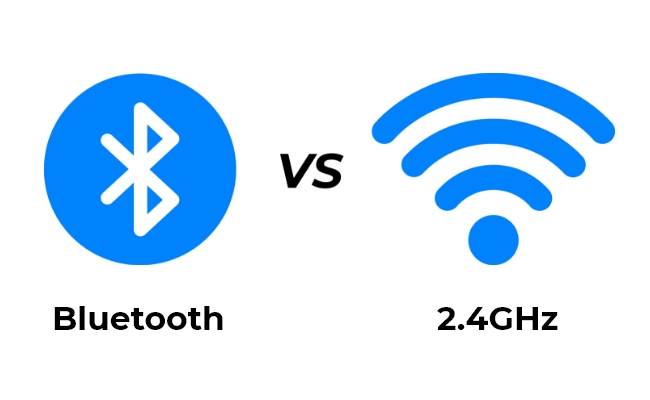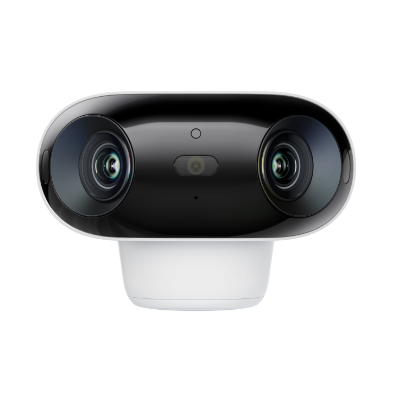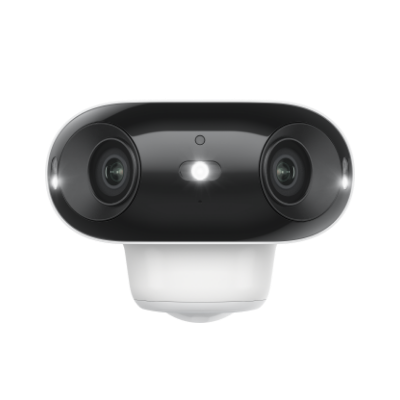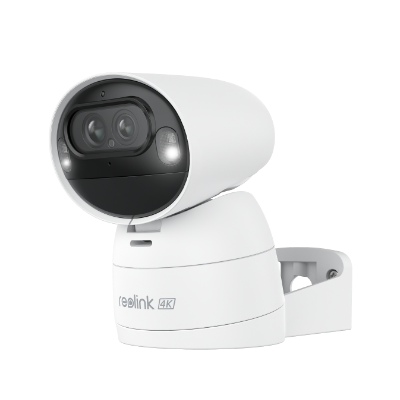Bluetooth vs 2.4GHz: What's the Difference?

If you are looking for a wireless device, whether a security camera, mouse, or keyboard, you might have come across two options: Bluetooth and 2.4GHz. Both of them are wireless technologies, but they differ in various aspects.
In this article, we will discuss what Bluetooth and 2.4GHz technology are. We will explain the difference between them and which is suitable to make your selection easier.
Bluetooth vs 2.4GHz: Basics of Bluetooth
What is Bluetooth?
Bluetooth is a wireless technology that facilitates the connection of devices. It is suitable for a short range and uses radio waves.
Bluetooth devices can be directly connected without the need for a third-party device. Depending on the class, both devices should be within a 10-100 meter range.
It is commonly used to connect mobile phones, smartwatches, headphones, keyboards, mice, etc.
Pros and Cons of Bluetooth
Pros:
- Extremely affordable option, which is why it is widely adopted
- It consumes low power, so the battery of the device can last longer
- Excellent compatibility with various devices
- Easy and quick pairing process
Cons:
- The range is very short
- The data rate is slow, which is why only small files and minimal data can be transferred
- Not a very secure option. There are risks of data leakage and malware
Bluetooth vs 2.4GHz: Basics of 2.4GHz
What is 2.4GHz?
2.4GHz is a wireless technology that operates at a radio frequency of 2.4GHz. It is also used for short-range connection but is way better than Bluetooth.
The important feature of this connection is that it can penetrate through walls and objects.
Pros and Cons of 2.4GHz
Pros:
- Offers a better range than Bluetooth
- Can penetrate through walls and objects
- Has encryption to ensure secure transmission
- Has lower latency to support fast operation
Cons:
- More susceptible to interference
- Requires a receiver device for connection, which is bulky
- Costs more than Bluetooth due to the complex technology
Bluetooth vs 2.4GHz: Comparison between Them
Bluetooth and 2.4GHz are wireless technologies, but they differ in various aspects. Before choosing either, consider the following differences.
Range
The range of Bluetooth is less than 2.4GHz. It varies between 10 meters to 100 meters.
There are three classes of Bluetooth. The range of these classes is as follows:
- Class 1: 100 meters
- Class 2: 10 meters
- Class 3: 1 meter
Class 2 is widely used in the common electronic devices we use every day.
In contrast, 2.4GHz has a range of up to 100 meters. It is better suited for penetrating walls, doors, and objects.
Data Rate
Bluetooth is suitable for those operations where the data does not exceed 3Mbps. That's why it connects mobile devices, smartwatches, and audio devices and transfers small files.
2.4GHz is way better in data rate. It can transfer more data at a speed of up to 300Mbps or more, but it depends on the Wi-Fi standard.
Interference
Interference is a major issue in wireless connections.
Both Bluetooth and 2.4GHz are susceptible to interference. However, 2.4GHz is affected more.
Bluetooth works on different channels at a very high frequency, which reduces the effect of interference to a certain level.
Power Consumption
The power consumption of Bluetooth is very low, which is the reason it is preferred for small devices where batteries are small.
2.4GHz consumes more power to offer a better range and data rate.
Bluetooth vs 2.4GHz: Which Applications You Should Choose?
The selection of Bluetooth or 2.4GHz depends on the application. In some cases, Bluetooth could be the best option, while in other cases, 2.4GHz can be better.
Bluetooth vs 2.4GHz Mouse
Bluetooth mice are widely used because they are cheap and can do the job well. They do not require a USB receiver, and they are also more compact and smaller.
They are suitable for most cases. But keep in mind that they have higher latency, which can cause delays. The range is also shorter.
So, if you cannot compromise on the speed, such as while playing games, you need a precise mouse. In that case, 2.4GHz would be the best option.
2.4GHz has lower latency and better range. However, it requires a USB receiver, which is connected to a USB port, and it is larger than a mouse dongle.
Now, you can choose according to your needs.
Bluetooth vs 2.4GHz Keyboard
This decision is also similar to the mouse.
Bluetooth keyboards are mostly used and preferred. They are cheap and suitable for most cases. You can use them for normal typing and other usage. However, they are not designed for gaming and high-speed operations where you can't bear high latency.
2.4GHz offers better range and lower latency. It is great for gaming and professional typists. However, it requires a USB receiver to work.
Depending on the application of the keyword, you can select a Bluetooth or 2.4GHz keyboard.
Bluetooth vs 2.4GHz Security Camera
When it comes to security cameras, the best option is to go with 2.4GHz. Bluetooth cameras offer limited range and have security concerns.
However, Reolink has introduced a camera that can connect both via dual-band WiFi and Bluetooth. Its name called Argus 4 Pro.
Featuring dual-band Wi-Fi 6 technology, the Argus 4 Pro ensures seamless 4K streaming with improved stability and reduced latency. This advanced connectivity not only provides better performance but also supports Bluetooth connectivity for added convenience.
4k 180° Wire-free Color Night Vision Camera
4K UHD 180° Blindspot-free View; Color Vision Day and Night; 30% More Battery Life; Dual-band Wi-Fi 6; Smart detection.
For customers who need full-color night vision without visible spotlights, the Reolink Argus 4 Pro is the ideal alternative. Alternatively, if you want an affordable option that nonetheless provides good performance, the Argus 4 standard version is worth considering.
4k 180° Blindspot-free Wi-Fi 6 Camera
4K UHD 180° Blindspot-free View; Dual-band Wi-Fi 6; Smart detection; Easy Installation Anywhere
If you are looking for an excellent 2.4GHz security camera, you can go with Reolink Argus Track. It is a Wi-Fi camera with dual bands, 2.4GHz, and 5GHz, to ensure better speed and stable connection. It can be accessed from any location, and you can see the live preview.
It is a PTZ camera that covers a wider area. It offers 4K video for optimal clarity and can zoom into objects to unveil intricate details. It can also work at night and offer colored videos. The notable features of the camera are auto-tracking, instant alerts, two-way audio, double-warning, time-lapse, etc.
4K Dual-Lens Wi-Fi Solar/Battery Camera
4K 8MP Ultra HD, Auto-Zoom Tracking, Pan, Tilt & 6X Hybrid Zoom, Color Night Vision, Dual-Band Wi-Fi.
FAQs
1. Is 2.4GHz or Bluetooth better?
It depends on the application. In some cases, Bluetooth is a better option, while in other cases, 2.4GHz could be better. However, in terms of data rate, range, and latency, 2.4GHz is better.
2. Can you connect 2.4GHz to Bluetooth?
No, you cannot connect 2.4GHz to Bluetooth. Both are different technologies, and they are not compatible. That said, a device with Bluetooth cannot be connected to 2.4GHz and vice versa.
3. What is the difference between 2.4 and Bluetooth controllers?
2.4GHz controllers are more advanced compared to Bluetooth. They offer better latency, data rate, and range. And they require a receiver for the connection. On the other hand, Bluetooth controllers are more compact than 2.4GHz. It does not require a receiver for the connection, as the device usually has Bluetooth functionality.
4. Does 2.4GHz affect Bluetooth?
Yes, 2.4GHz affects Bluetooth. This is because Bluetooth is susceptible to interference. Any signal of similar frequency can interfere, and so does 2.4GHz.
Conclusion
Bluetooth and 2.4GHz are commonly used wireless technologies. But the question for common uses is: which one should they pick? We have explained what these technologies are and how they differ. Both are great in certain scenarios, so you have to pick the right one according to the application. Consider their features, specifications, and differences to make the right decision.
Search
Be in the Know
Security insights & offers right into your inbox



